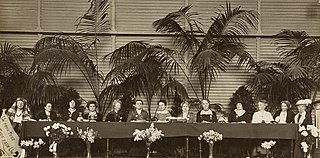Women at the Hague

Women at the Hague was an International Congress of Women conference held at The Hague, Netherlands in April 1915. It had over 1,100 delegates and it established an International Committee of Women for Permanent Peace (ICWPP) with Jane Addams as president. It led to the creation of the Women's International League for Peace and Freedom (WILPF).[1]
Preparations[]
The 1915 International Congress of Women was organized by the German feminist Anita Augspurg, Germany's first female jurist, and Lida Gustava Heymann (1868–1943) at the invitation of the Dutch pacifist, feminist and suffragist Aletta Jacobs to protest the war then raging in Europe, and to suggest ways to prevent war in the future. The scheme of an International Congress of Women was formulated at a small conference of women from neutral and belligerent countries, held at Amsterdam early in February 1915. A preliminary programme was drafted at this meeting, and it was agreed to request the Dutch women to form a committee to take in hand all the arrangement for the Congress and to issue the invitations. The expenses of the Congress were guaranteed by British, Dutch and German women present who all agreed to raise one third of the sum required.[2]
Invitations to take part in the Congress were sent to women's organisations and mixed organisations as well as to individual women all over the world. Each organisation was invited to appoint two delegates. Women only could become members of the Congress and they were required to express themselves in general agreement with the resolutions on the preliminary programme. This general agreement was interpreted to imply the conviction (a) That international disputes should be settled by pacific means; (b) That the parliamentary franchise should be extended to women.[2]
The Congress[]
The Congress opened on April 28[3] and was attended by 1,136 participants from both neutral and belligerent nations,[4] adopted much of the platform of WPP and established an International Committee of Women for Permanent Peace (ICWPP) with Jane Addams as president. WPP soon became the US Section of ICWPP
The Congress was carried on under two important rules:
- That discussions on the relative national responsibility for or conduct of the present war,
- Resolutions dealing with the rules under which war shall in future be carried on, shall be outside the scope of the Congress.[2]
Delegations[]
There were problems in getting 1200 women together during wartime. The delegation from Britain was trimmed by the Foreign Office to 24 delegates and actually only two (or three) made it to the Hague. Italy only managed one delegate and she was keen to note that she did not represent her country. One woman also came from Canada to represent what was called at the time "the Colonies".[5]
Countries represented included the United States, which sent 47 members; Sweden, 12; Norway, 12; Netherlands, 1,000; Italy, 1; Hungary, 9; Germany, 28; Denmark, 6; Canada, 2; Belgium, 5; Austria, 6, and Great Britain, 3, although 180 others from there were prevented from sailing owing to the closing of the North Sea for military reasons. The Congress, which was attended by a large number of visitors as well as by the members, was extremely successful. Proceedings were conducted with the greatest goodwill throughout, and the accompanying resolutions were passed at the business sessions.[2]
Committee members[]
- Austria: Leopoldine Kulka,
- Armenia: Lucy Thoumaian
- Belgium: ,
- Denmark: Thora Daugaard, Clara Tybjerg
- Germany: Dr. Anita Augspurg, Lida Gustava Heymann (Secretary and Interpreter)
- Great Britain and Ireland: Chrystal Macmillan (Secretary), Kathleen Courtney (Interpreter)
- Hungary: Vilma Glücklich, Rosika Schwimmer
- Italy: Rosa Genoni
- Netherlands: Dr. Aletta Jacobs, (Secretary), Dr. Mia Boissevain
- Norway: Dr. Emily Arnesen, Louise Keilhau
- Sweden: Anna Kleman,
- USA: Jane Addams (President), Fannie Fern Andrews, Alice Hamilton[2]
See also[]
References[]
- ^ Paull, John (2018) The Women Who Tried to Stop the Great War: The International Congress of Women at The Hague 1915, In A. H. Campbell (Ed.), Global Leadership Initiatives for Conflict Resolution and Peacebuilding (pp. 249-266). (Chapter 12) Hershey, PA: IGI Global.
- ^ a b c d e Addams, Jane; Balch, Emily Greene; Hamilton, Alice (1916). Women at the Hague: The International Congress of Women and Its Results (Public domain ed.). Macmillan. pp. 146–149.
- ^ "International Congress of Women opens at The Hague". History.Doc. Retrieved 12 December 2014.
- ^ van der Veen, Sietske (22 June 2017). "Hirschmann, Susanna Theodora Cornelia (1871-1957)". Huygens ING (in Dutch). The Hague, The Netherlands: Huygens Institute for the History of the Netherlands. Archived from the original on 30 August 2017. Retrieved 30 August 2017.
- ^ "Hellraisers Journal: From The Survey: "Women of the Hague" a first-hand report by Mary Chamberlain". Daily Kos. Retrieved 2017-11-03.
Bibliography[]
 This article incorporates text from this source, which is in the public domain: J. Addams, E. G. Balch, & A. Hamilton's Women at the Hague: The International Congress of Women and Its Results (1916)
This article incorporates text from this source, which is in the public domain: J. Addams, E. G. Balch, & A. Hamilton's Women at the Hague: The International Congress of Women and Its Results (1916)
- Pacifist feminism
- Peace conferences
- 1915 conferences
- 1915 in the Netherlands
- Women's conferences
- April 1915 events